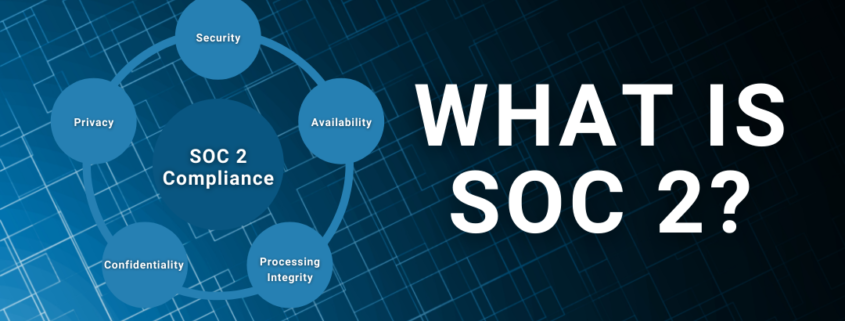What Is SOC 2?
What is SOC 2? This is a question that many people in the tech world are asking. System and Organization Control 2, or SOC 2, is a set of standards that organizations use to measure their information security, privacy, and compliance practices. By complying with these standards, organizations can prove to their customers that they take data security and privacy seriously. If you’re curious about how your company can achieve SOC 2 compliance, keep reading!
SOC 2 Compliance
SOC 2 is a compliance framework that was created to help organizations protect their customers’ data. It provides guidance on how to create and implement a security and privacy program that meets the needs of your business and your clients. In order to become SOC 2 compliant, an organization must go through an audit process to demonstrate that their program meets the required criteria.
Before you begin the audit process, it’s important to ensure your business has certain qualifications or better yet, the expected standards needed. This is where we suggest reaching out to an MSP, such as Data-Tech, to identify you have the correct security, privacy, and compliance practices in place. If you do not take these measures, there’s potential you will not have a successful audit and waste time and money engaging in the process.
SOC 2 Report
A SOC 2 report is a way for service organizations to demonstrate that general IT controls are in place and appropriate. The AICPA has developed a list of criteria that can be used to create a SOC 2 report. This standard is different from other information security standards because it does not have comprehensive requirements, but rather provides guidance on how service organizations should document their efforts to meet certain goals and objectives regarding risk management practices. This responsibility can be put on your MSP to avoid conflict or stress.
Trust Services Criteria (TSC) determines the five aspects covered in a SOC 2 report: Security, Availability, Confidentiality, Processing Integrity, and Privacy. Not all TSCs are required, but common criteria is best to point out with this information. More information may need to be added onto your reports depending on how much risk there seems to be for clients. For example, if the availability of healthcare data is extremely important to a service offering, then the availability criteria may be included in the SOC 2 report in addition to the security criteria.
Security – The system is protected against unauthorized access (both physical and logical). Examples of commonly reviewed SOC 2 security controls relate to the restriction of logical access within the environment to authorized individuals. Also, security configurations such as password complexity, MFA, and branch protection rules.
Availability – The system is available for operation and use as committed or agreed. The availability criteria require that a company documents a DR and BCP plan and procedures. In addition, it requires backups and recovery tests to be performed.
Confidentiality – Information that is designated “confidential” is protected according to policy or agreement. In many cases, this covers business-to-business relationships and sharing of PII or sensitive data from one business to another.
Processing Integrity – System processing is complete, accurate, and authorized. Processing integrity may be relevant to companies that process transactions such as payments or errors made by your company such as flawed calculations or processing could impact your clients’ financials or significant processes. If processing integrity is relevant and included in a SOC 2 report, the auditor will review evidence that processing is complete and accurate, and errors related to processing are identified and corrected.
Privacy – The privacy criteria should be considered when “personal information is collected, used, retained, disclosed, and disposed of to meet the entity’s objectives.” It’s important to note that the privacy criteria apply to personal information. This differs from the confidentiality criteria which applies to other types of sensitive information.
Is SOC 2 Right For Me?
There are three different types of SOC reports: SOC 1, SOC 2, and SOC 3. SOC 1 and SOC 2 are further detailed into a Type I or Type II report, while SOC 3 always comes as a Type II report.
Here’s a quick breakdown of SOC 1, SOC 2, & SOC 3:
SOC 1– focuses on a service organization’s internal controls relevant to user financial reporting. SOC 1 reports can be either Type I or Type II.
SOC 2– focuses on controls relevant to compliance and operations, outlined by the AICPA’s Trust Services Criteria (TSCs). SOC 2 reports can be either Type I or Type II.
Type I– Type I audit report helps the service organization to implement the discipline necessary to successfully complete an unqualified Type 2 audit report.
Type II– Type II audit report provides the user entity and the user entity auditors with a higher level of assurance for them to rely on.
SOC 3– focuses on an easy-to-read report on controls. SOC 3 report is always Type II.
What Data-Tech Can Do For You
We understand it may be difficult to determine which SOC report is best for you. As a SOC 2 Type II certified MSP, Data-Tech’s experts have the knowledge to identify best measures for your business.
If your service organization’s controls impact customers’ internal control over financial reporting, then you need to be assessed in accordance with SOC 1 guidelines. A SOC 2 report is an extensive document with detailed information on the system, the controls in place, and what their auditor’s test procedures were, which is the key difference compared to a SOC 3 report. A SOC 3 report is more of a general use report that does not include much detail, but is great for marketing purposes.
Contact us to begin your SOC journey.
Source: https://linfordco.com/blog/soc-2-vs-soc-3/




